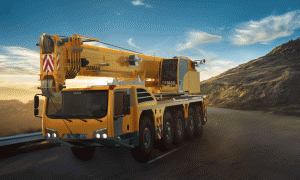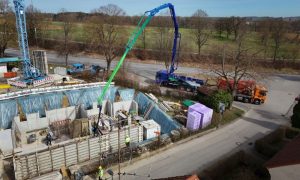The big show: Bauma 2016 in review
Bauma 2016 defied the doldrums in the construction machinery industry to record increases in the numbers of visitors, exhibitors and orders

The 31st triennial Bauma show, held April 11-17 at the Messe Munchen in Munich, was a seven-day event of superlatives. The world’s leading trade fair for construction machinery, building material machines, mining machines, construction vehicles and construction equipment, Bauma 2016 attracted around 580,000 visitors from 200 countries to the capital of Bavaria in Germany – an increase of more than 9%.
After Germany, the top ten countries of origin among visitors were Austria, Switzerland, Italy, France, the Netherlands, the UK, Sweden, Russia, Poland and the Czech Republic. A total of 3,423 exhibitors – 1,263 from Germany and 2,160 from elsewhere – from 58 countries presented products, developments and innovations on 605,000sqm of exhibition space, with which the show broke its own record set last year for the biggest exhibition in the world. Exhibitors from outside Germany accounted for 63% of the total, higher than ever before.
“The response from the participants this year was amazing. The visitors at Bauma always come looking to invest, but this year the exhibitors’ order books filled up much faster than expected. Many exhibitors are talking about a record level of demand at Bauma 2016. And that is an extremely positive sign in this current uncertain climate,” says Klaus Dittrich, chairman and CEO of Messe München.
Johann Sailer, chairman of the VDMA Association for Construction Machinery and Building Material Machines, agrees: “Bauma is the ideal platform for presenting innovative new developments, because it has a big impact in the industry around the world. Again in 2016, the world’s largest show of construction machinery delivered impetus for further growth in our sector.”
As well as breaking records in terms of exhibitor and visitor numbers and exhibition space, Bauma 2016 was also a great place for filling the order books. Stefan Heissler, a member of the Board of Directors of Liebherr-International AG, confirms: “Bauma 2016 was a tremendous success for Liebherr. We received many orders from a wide variety of different markets. In some segments our expectations were even exceeded.”
For Michael Heidemann, vice-chairman of the Management Board of Zeppelin, “Bauma 2016 has once again shown everyone that it does indeed boost innovation and it has lived up to its reputation for being the leading trade fair.”
Jürgen and Stefan Wirtgen, managing partners in the Wirtgen Group, agree with this assessment: “Bauma as the leading trade fair has always been a kind of barometer for the industry, and from the start it had a very special significance for our company. Our presentation at this year’s Bauma was the most successful so far in the history of the company.”
The mining section at Bauma also received a very positive response, as Erwin Schneller, managing director of SBM Minerals, reports: “Bauma is very international. We had visitors from Chile to Canada, from China to Russia, from South Africa to Norway. My personal highlight was that we signed up some unexpected sales at the show.”
Middle East interest
The number of visitors from the Middle East also followed the general growth trend to record a rise over previous years. The GCC especially surprised many exhibitors by the number of visitors it contributed to the show.
Speaking about the interest from the Middle East, Shahir El Essawy, business director for Hub South (Middle East & Africa) at Volvo Construction Equipment – Sales Region EMEA, says: “The event this year far exceeded expectations and we had more visitors from GCC countries to the Volvo stands than any other year. The outdoor demo area was also a huge hit and was very much appreciated by all visitors. Many customers from GCC countries showed a lot of interest in our products and services, especially our newly launched products at Bauma 2016.”
Commenting on the significance of Bauma for Volvo CE, he adds: “Bauma allows us to demonstrate the strength of the Volvo Group to thousands of customers – how our highly efficient and productive machines from Volvo CE and reliable on-road construction trucks from Volvo Trucks can work together in a customer’s operations, as well as the powerful and environmentally-conscious engines from Volvo Penta. Volvo CE’s sister brands, SDLG and Terex Trucks, also exhibited at Bauma this year, showcasing the Volvo Group’s capabilities in the value construction equipment and light mining segments.”
For Volvo CE, the main product launches at the show were the Volvo A60H articulated hauler and the Volvo EC950E excavator. Both models represent new size classes for Volvo CE, and the A60H is the largest true articulated hauler ever on the market.
“We are bringing both new machines to the GCC through Famco, our distribution partner in the region,” El Essawy adds. “The Volvo EC950E is the perfect size to load the new hauler and we are confident of its success, given the proven track record of the Volvo EC750E model. We took some important orders on these new heavyweight models, so we are off to a good start.”
Meanwhile, other entities from the GCC were also checking out the market at Bauma for new launches and products to bring to their local markets. Among them was crane and work platform rental specialist Johnson Arabia, whose team was at Bauma to get a view of the latest developments in the sector and window shop for new machinery.
“Attending Bauma is a must in our line of business, because this is where we get an overview of the industry every three years and get to know about the latest trends, technologies and products,” a spokesperson for the company says. “At Bauma 2016, we again made an assessment of where the industry stands and spotted some new products that would be great additions to our Middle East fleet, such as the Demag crane line reintroduced by Terex. We will base our future fleet expansion decisions based on the knowledge we have gathered at the show.”
Other manufacturers echoed Volvo CE’s sentiments about the importance of the show and their success in it. Alexander Schwörer, managing director of Peri, says: “For us, Bauma 2016 was a tremendous success. We are very satisfied with the response and with the high quality of the trade visitors.”
Also impressed was Frank W Reschke, sales director and member of the Management Board of Masa: “We are very happy with how the show went. Right from day one, we were welcoming a constant stream of guests from all over the world at our booth. The quality of the trade audience is first-rate, as it was three years ago, and we had some excellent business talks.”
Bauma is also the number one platform for exhibiting companies to premier their innovations to a global trade audience. John L. Garrison, CEO & president of Terex Corporation, emphasises: “Every three years, Bauma offers us the unique opportunity to meet with customers from around the world. As the largest trade show in our industry, the 31st edition this year was a good opportunity to showcase new products and services.”
Masatoshi Morishita, managing director & CEO at Komatsu Europe, sums it up neatly when he says: “We made use of the attention Bauma 2016 attracted to present our innovations. This event is a milestone for the industry. It’s not only Komatsu that tries to get certain machines ready in time for Bauma. This trade show really drives the entire industry forward.”
Bauma awards honour innovators
Six companies and research institutions were honoured with the Bauma Innovation Award at Munich this year, as part of Bauma 2016. The awards, a feature of the triennial exhibition, were presented a day before the start of the event during a ceremony in the Allerheiligen-Hofkirche church in Munich.

The Bauma Innovation Award is “a reflection of the innovativeness of the German and international construction, building material and mining machine industry”, said Bavaria’s Minister of Economic Affairs Ilse Aigner, praising the award winners and the other companies that took part in the competition. “It serves not only as a demonstration of what is technically feasible, but also points the way to the future,” she added.
The six winners of this year’s award were Kramer Werke GmbH, Pfullendorf, for machinery; IMKO GmbH, Ettlingen, for components; Leonhard Weiss GmbH & Co KG, Göppingen, for construction work and process; the Technical University of Dresden’s Department of Construction Machinery Technology, for research; as well as the university’s design department, for design; and the only non-German winner, the GroupeMecalac S.A. from Annecy-le-Vieux, France, also for design.
Johann Sailer, chairman of the German manufacturers of construction and building material machines included in the German Engineering Federation, notes that interest in the competition has grown among international companies, who accounted for almost half of all applications for the award. “The award also generates momentum for the entire industry. And Bauma is an exceptional platform for this, as it is the highlight of the industry, something that attracts tremendous attention around the world.”
The winner in the machinery category, Kramer-Werke GmbH, was honoured for its 5055e vehicle, a fully electric wheel loader with all-wheel steering. The emission-free machine is optimally suited for jobs in buildings and tunnels. It also eliminates the need for costly ventilation systems, and its traction drive and work hydraulics are powered by an electric motor.
In the components category, IMKO GmbH was recognised for its Sono-WZ device, a hand-held analyser that can quickly, accurately and easily measure the moisture content of fresh concrete. The parameters of the concrete are input. A sensor attached to a rod is then dipped into a bucket filled with concrete several times. The display subsequently shows the moisture level. Long waiting times like those required by the conventional Darr method thus become a thing of the past. This prevents concrete from setting prematurely and increases the quality and lifespan of concrete structures.
The award in the category of construction work and processes was presented to Leonhard Weiss GmbH & Co KG for a pilot project in which the deteriorating driving surface of a steel bridge was rehabilitated quickly and at relatively low cost.
The Department of Construction Machinery Technology at the Technical University of Dresden won the award in the research category for its ongoing research into 3D printing for concrete. In contrast to previous approaches, researchers at Dresden not only bring 3D printing directly to the construction site, but also use available machines as the basis for their new technology.
In the design category, Mecalac was honoured for its new generation of mobile excavators, and the Technical University of Dresden and its collaborators were awarded for their jointly developed driver’s cab, called Genius Cab.
The new mobile excavators produced by Mecalac use a design that exudes not only power and stability, but also dynamism and value, the jury said. The jury was also impressed by the way that the revolving upper deck and undercarriage had been integrated, which they said clearly demonstrates how technical progress and design can be combined. The jury also viewed the Genius Cab as a successful integration of technology and design, which communicates a feeling of safety and strength.
Terex resurrects Demag
The highlight of Bauma 2016 for Terex Cranes was the announcement of the return of its legendary Demag cranes brand. The company showcased three updated five-axle machines that are part of the Demag all-terrain crane family. The Demag range consists of 11 all-terrain cranes, ranging from 100t to 1,200t of capacity, and seven lattice boom crawler cranes, ranging from 400t to 3,200t of capacity.

Under the theme “A Legend Is Reborn”, the re-launch was announced to the international press and Bauma visitors on April 11 and celebrated at the Terex booth with a spectacular show.
“I am very excited that we are reintroducing the Demag brand. We’re doing it because our customers asked us to bring the Demag brand back. It is as simple as that,” says Ken Lousberg, president of Terex Cranes. “The Demag brand is a legend, and through extensive conversations with our customers we understand how much the brand still means to them, and what their expectations are that go along with it. It’s a brand they have depended on every day for decades, and it continues to be one of the most recognised brands in the industry.”
“We will continue to operate as one organisation representing two brands, and no matter if our customers buy Terex or Demag branded products, they can expect top quality, reliable products and a team that is proud to stand behind the products and services we offer.”
The Demag brand has a history of engineering change to transform the lifting industry. From major advances that introduced the most powerful all-terrain cranes and crawler cranes in the world to incremental improvements that helped to advance safety and handling, Demag is known for its track record of innovation, which Terex says it will seek to recapture.
Bauma visitors had the opportunity to explore both Demag and Terex cranes exhibited at the show and watch the Demag show at the Terex booth every day during the event.
JCB’s next-gen Midis
JCB released four models of midi excavators at Bauma 2016, with 4.8-5.7t operating weights. The midi excavators are available in conventional, reduced and zero tailswing configurations, to meet the requirements of customers across the world. The four new models are the 48Z-1, 51R-1 and 55Z-1 – which are replacements for older models – and the all-new 57C-1.

Key features of the new launches include 500-hour greasing intervals, improved cab instrumentation, 18% increase in operator cab capacity, 11% improvement in visibility, 9% boost to bucket tearout, 5% additional dump height and 2% more powerful bucket tearout force.
The dig end is 100% bushed, leading to extended 500-hour greasing intervals. JCB has also revised the pin pick-up points to work with a number of competitive bucket brands, while optional hydraulic or manual quick hitches can be specified for faster attachment changeover. JCB has developed a new range of ECO buckets, with a redesigned profile for easier filling and improved material retention.
The excavators feature a redesigned dig end, with a longer main boom and shorter dipper arm, to provide up to 5% greater dump height for easier truck and site dumper loading. The upgraded hydraulic system also delivers up to 9% more bucket tearout force and 2% higher dipper arm tearout, boosting performance and productivity.
The excavators feature an improved operator’s cab, with the 57C-1 offering an 18% more spacious cab with up to 11% more visibility. Even in reduced and zero tailswing configurations, the midi excavators deliver reduced noise and vibration levels. The biggest development in the cab is the adoption of a new display screen and control system, with an automotive style rotary controller allowing easy access to a host of systems and information. The operator can set auxiliary hydraulic flows for two separate attachments from the cab, while the menu mode button switches the rotary controller between throttle modes, including a one-touch idle function and menu mode.
Grove and Potain heavyweights
Manitowoc launched two new Grove all-terrain cranes for the global market at Bauma in the 150t category – the five-axle GMK5150 and GMK5150L cranes, which claim the best load charts in their class, both in taxi configuration and when configured for optimal capacity with maximum counterweights.

Both cranes have compact designs for improved manoeuvrability, Manitowoc said at the launch. The GMK5150L, which was displayed at Manitowoc’s stand at Bauma 2016, features a 60m boom, while the GMK5150 has a 51m boom. The GMK5150L replaces the GMK5130-2 and the GMK5150 replaces GMK5110-1 in the company’s product line.
According to Manitowoc, the GMK5150L is ideal for tower crane assembly or other applications where strength at height is required. It has a capacity of 11.6t with its boom fully extended to 60m. Boosting both cranes’ overall reach is an 18m bi-fold swing-away jib, which can be extended with an 8m boom extension and an 8m jib extension, for a total jib length of 34m.
Jens Ennen, senior vice president, All-Terrain and Truck-Mounted Cranes at Manitowoc, said: “With class-leading load charts and specifications, the new GMK5150L and the GMK5150 are highly mobile cranes that continue this tradition. These cranes will maximise return on investment for our customers through their superior reliability, ease of transportation and user friendliness.”
Powering the cranes is a single Tier IV Final/EUROMOT 4 Mercedes-Benz OM471LA six-cylinder diesel engine, with a 390kW rating at 1,700rpm and a maximum torque rating of 2,460Nm at 1,300rpm. An overall width of 2.75m and 16-inch tyres ease mobility at congested job-sites. Operator efficiency is also maximised through Manitowoc’s Crane Control System (CCS), with the company’s standardised interface and in-house software.
Manitowoc also revealed three of its most advanced Potain tower cranes at Bauma, including the first from a new product line. The all-new MDT 389 is the largest in the new line of topless cranes from Potain, all equipped with Manitowoc’s Crane Control System. The complete range consists of the MDT 249, MDT 259, MDT 269, MDT 319 and the MDT 389.
“We are at the forefront of tower crane development, and with the introduction of CCS to our Potain cranes, we are securing our market leadership position for years to come,” said Jean-Noel Daguin, SVP of Potain Tower Cranes at Manitowoc.
A Case for handling
Construction equipment maker Case, part of the CNH Industrial group, revealed a new model in its D Series range of crawler excavators at Bauma 2016. The new CX290D material handling crawler excavator is designed and engineered for material handling applications, with superior reach and lifting capacity, according to Case. The dedicated elevating cab structure provides the operator with a commanding view of the working area from a height of 5.06m, and the reversible fan cleans the radiators more effectively, keeping high performance in the dusty conditions typical of many material handling applications.

The CX290D will also become available with goose necked arm and straight boom in the scrap loading version, the company added.
Several features ensure the safe operation of the elevating cab, such as the rigid elevating structure and the ability to lower the cab using the internal cab controls or an external control switch. For greater operator safety, its descent speed is limited in case of a burst hose, Case said at the launch, and the emergency cab lowering device is now operated hydraulically, further enhancing safety.
The CX290D is powered by a Tier4 Final/Stage IV engine with Selective Catalytic Reduction after-treatment system and diesel oxidation catalyst. The engine is DPF-free, which saves time and maintenance costs and delivers fuel-efficient performance.
Other new features on the CX290D include a new LED working light package, which is more than three times brighter than its halogen equivalent. A third camera is also available to further enhance all-round visibility, Case revealed.
Hitachi’s hit hybrid
Hitachi went green at Bauma 2016 by launching the ZH210LC-5 hybrid excavator, an innovative Zaxis-5 model that has been designed to deliver reliable performance with fewer emissions and less fuel than conventional models. The ZH210LC-5 hybrid incorporates advanced technologies adopted from hydraulic, electric and battery-powered excavators, resulting in the TRIAS HX system, which reduces fuel consumption and CO2 by up to 31%.

The ZH210LC-5 provides energy-saving performance without compromising on power, speed or ease of operation, owing to the flexible combination of a proven hydraulic motor and an eco-friendly electric motor, which enables it to have the same level of efficiency and smooth swing motion as all other Zaxis-5 models, the Japanese giant said.
The TRIAS HX system combines a hybrid system with an energy-efficient TRIAS hydraulic system to achieve low levels of fuel consumption. The hybrid system incorporates a swing motor that converts energy generated during swing braking into electrical energy. This is transferred via the power control unit and stored in the capacitor unit, before being used to help the engine accelerate and move the upper structure.
The energy-efficient TRIAS hydraulic system employs a three-pump/three-control valve system, which results in greater accuracy and reduces pressure loss that consequently saves energy. The ZH210LC-5 also has an electric power assist system that comes into force for small swing operations. It uses energy from electric swing motors to carry out such movements, further reducing the machine’s fuel consumption.
Hitachi said the machine had been tested in temperatures as low as -30°C by experienced operator Kari Saraniemi, who said in his assessment: “The swing motion on the hybrid excavator means that it is even more smooth and precise than a conventional machine. In addition, it was less noisy in the cab in the winter test and the fuel consumption was excellent.”















